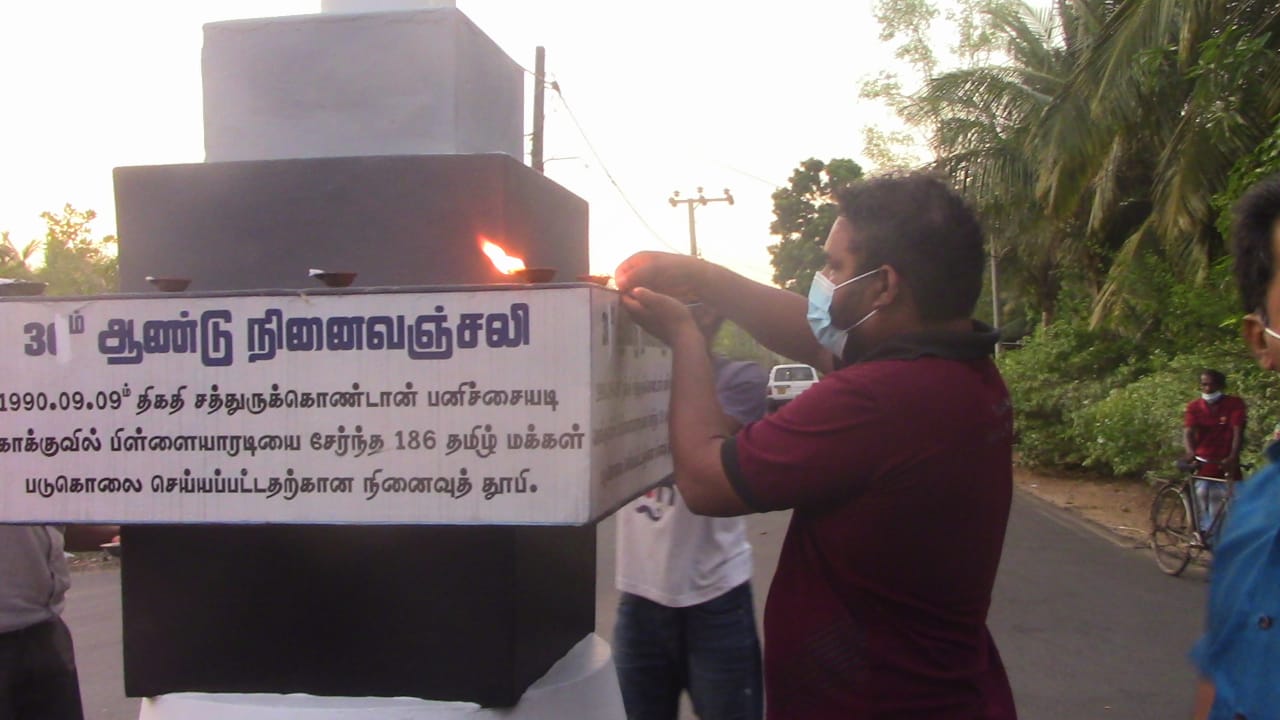
Image from last year's memorial in Batticaloa
Today marks the 32nd anniversary of the Saththurukondan massacre where 184 Tamils were killed by the Sri Lankan army.
On September 9, 1990, the men, women and children from Saththurukondan and surrounding villages, on the outskirts of Batticaloa, were taken to an army camp by Sri Lankan soldiers, where they were massacred.
The mass killings, which were carried out during the presidency of the UNP's Ranasinghe Premadasa, were investigated in a probe established by then-president Chandrika Kumaratunga in 1997. The probe identified three captains in the Sri Lankan army as being responsible for the killings. The retired judge who led the inquiry, K Palakidnar said that there was strong evidence for the massacre and urged Ms Kumaratunga to hold the perpetrators to account, however no action was taken by the government.
Amongst those who were killed in the Sathurukondan atrocities, were five children less than a year old, 42 children under 10, 9 pregnant women and 28 adults over 68 years of age. 38 were from Saththurukondan, 37 from Panichchaiyady, 62 from Pillaiyaradi and 47 from Kokuvil.
Only one man survived the massacre and lived to tell his account to the ICRC and human rights groups.
Speaking to TamilNet in 1997, Mr K Krishnakumar, recounted what happened that day:
"The villages were cordoned off by the Army around 10 a.m. It was almost 7 p.m. by the time the villagers - including infants, women, pregnant mothers and the old - were herded to the Sathurukkondan camp and locked inside. Four masked men walked into the hall and selected me, T. Kumar, C. Sinnaththamby, and K. Jeevaratnam. Our shirts were removed and our hands behind our back with them. Then we were taken to the camp's back yard. We were dragged about fifty meters further, where we saw a pit about 20 ft by 5ft. There was a Cashew tree by the pit and well which was about 10 meters from it.
"In the dim light I saw 25 soldiers armed with long swords and cudgels standing round the pit and the well.
"I was hit with a cudgel and I fell face downward. When the other three screamed the soldiers stripped them and stuffed cloth into their mouths. One by one they were taken to the edge of the pit and hacked with swords and were pushed in.
"A soldier came up to me and slammed me against the Cashew tree, pulled out a long kris knife, and stabbed me through the chest. He then pushed me into the pit. He stabbed me again on my back. Though I was bleeding, I didn't lose consciousness.
"Four more men were brought there, hacked to death and were pushed in to the pit. The soldiers went again and brought two pregnant women. They were stripped naked and their breasts were sliced off. The soldiers then cut open the stomachs of these women with their swords and pushed them into the pit.
"Later they brought many girls stark naked. Sand was stuffed in the girls' mouths and all were raped repeatedly. Then the soldiers cut off their breasts with the swords. Three of these girls were pushed into the well. "As the area was dark, I was able to slowly crawl out while they were busy raping, killing and pushing bodies into the pit. When the soldiers left, I crawled towards the camp fence and hid in shrub jungle behind the camp. Later the soldiers brought tires and set fire to the bodies in the pit. The fires burned till 3 about a.m. in the morning. Once the pyre died out, the pit was filled with sand. With the help of a passer-by I went to the hospital.
Last year, two Batticaloa Municipal Councillors Thuraisingam Mathan and Thayalakumar Gowry, were summoned by Sri Lankan police for marking the 31st anniversary of the massacre.
Sri Lanka has continuously repressed Tamil memorialisation activities in the North-East either by enforcing legal restrictions or by harassment and intimidation by the state's security forces.
